Day 146: Siem Reap – Beng Mealea (80m) 63km. Mixture of dirt roads and sealed highway.
Day 147: Beng Mealea – Koh Ker (80m) 69km. Rolling sealed and dirt roads.
Day 148: Koh Ker – Kuleaen (100m) 24km + 18km in morning at temples. Rolling seal.
Day 149: Kuleaen – Sra Aem (100m) 79km. Wide, newly sealed and flat through endless wetlands.
Day 150: Rest Day visiting Prasat Preah Vihear temple.
Most people would be ‘templed out’ after 4 days around Siem Reap, but what we’d seen there had given us a hunger to check out some of Cambodia’s more remote and junglier temples: Beng Mealea, Koh Ker and Prasat Preah Vihear. Besides, this ‘temple trail’ would make a logical route north towards Thailand for us, allowing us to travel through one of Cambodia’s least visited and poorest regions.

We tried to take back roads between Siem Reap and Beng Mealea, but rapidly got confused by a network of roads that weren’t on our map. And when the roads were there, with the wet season flooding sometimes they disappeared under long stretches of water. We managed to patch together a reasonably direct route though. As usual it was great to see everyday Cambodians farming and working with age-old practices.

When we weren’t sure of the next turn we just asked locals – who were pretty keen to check out two random white people on space age bikes.
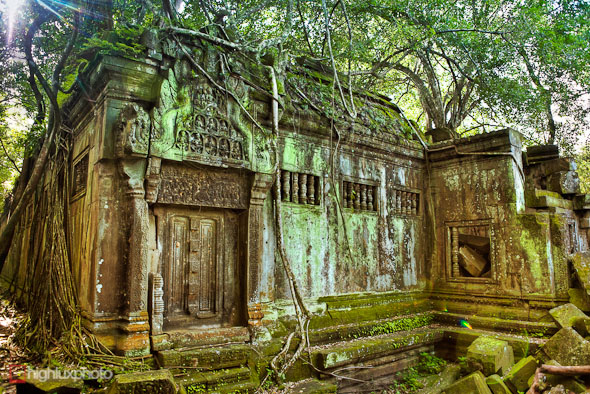
We arrived in the tiny village of Beng Mealea late in the afternoon, and were pointed in the direction of a basic (unsignposted) homestay/guesthouse for the night. The guesthouse was suitably budget, with just a mattress on the floor of a Cambodian family’s house, but it suited us nicely. The temple complex itself was only a five minute walk away and at dawn the next morning we were scrambling through the collapsed galleries looking for good photo spots.

Many people visit Beng Mealea on a day trip from Siem Reap, but we had it to ourselves for a couple of hours before any other tourists arrived. The temple’s pretty much completely unrestored and apart from a bit of jungle control probably looks much as it did when it was first seen by European explorers in the 18th century.

Far into the future maybe some of our cities will look like this as nature reclaims them.

A wooden walkway (built for a film that was made here) makes it easy to get around, but it’s way more fun to wander along the wall-tops and duck into the collapsed corridors.

A group of local kids, always keen to ‘guide’ you in return for tips showed us a few secret spots.

This giant tree might span 10 generations and that’s not even half as old as the temple itself.

Yet another reminder of this country’s not-so-distant violent past. As we head further north we’re getting closer to former Khmer Rouge strongholds, some of which held out until 1996.
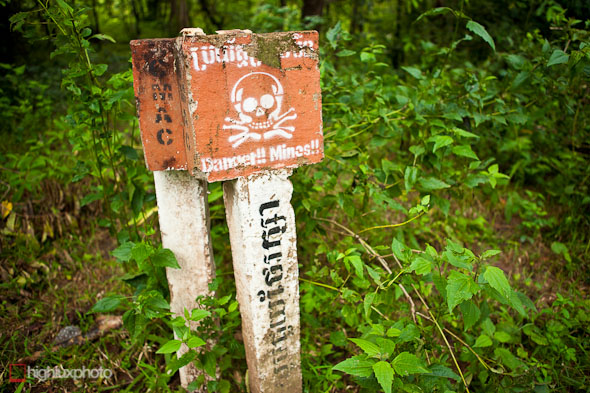
The other was warning signs for landmines. These had been a concern since Beng Mealea onwards (there were warnings there also), so we’ve been extra careful with our roadside ‘comfort stops’!

On a lonely section of dirt road surrounded by swamps we came across a banana stall run by this friendly guy. The bananas were just what we needed, and the guy was totally stoked with a packet of 3-in-1 coffee we gave him; slowly turning it over and over in his hands and no doubt savouring it for later.
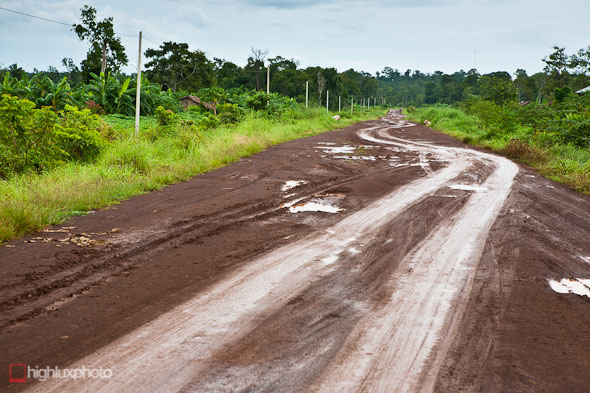
Hardpack Mud – if there is such a thing…

Koh Ker covers a large area, something like 5km x 3km but comprises many different temples in varying states of ruin. We arrived late afternoon and popped down the 8km access road for a quick look. The next day we left our kit at the guesthouse and rode in before sunrise in the hope of catching some light (and instead were rewarded with light drizzle and mist!)
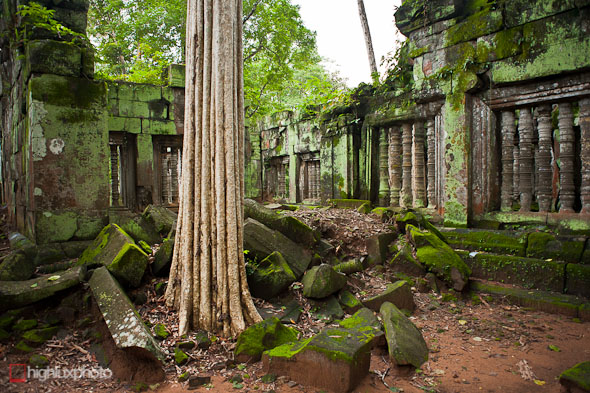
The ruins here aren’t overwhelmingly awesome in the way that Angkor’s main temples are, but they still illustrate the power and vision of a past empire as well as giving lots of ‘lost in the jungle’ feel.

There’s always cool details to appreciate among the chaos.

These signs are installed at each site to confirm the cleared area.

Partially collapsed tower at Prasat Chhin, Koh Ker.
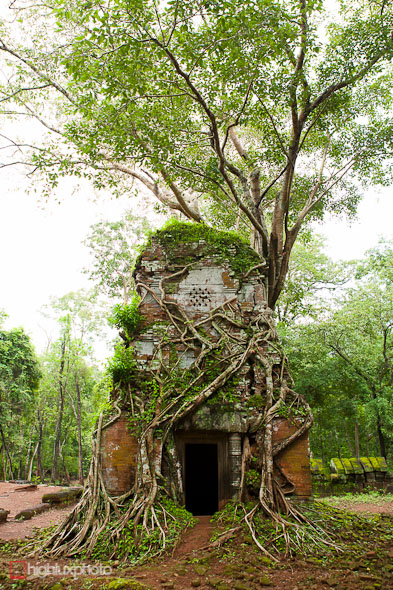
Koh Ker was the capital of the Khmer Empire from 928-944AD, just a brief hiatus from its 500 year stint at Angkor. For reasons unknown the captial was moved here, possibly by an usurper to the throne. After Jayavarman IV’s death the capital lasted a final three years under his son’s reign before being moved back to Angkor.

Three of the Wat Prasat Pram towers – probably the most evocative site at Koh Ker.
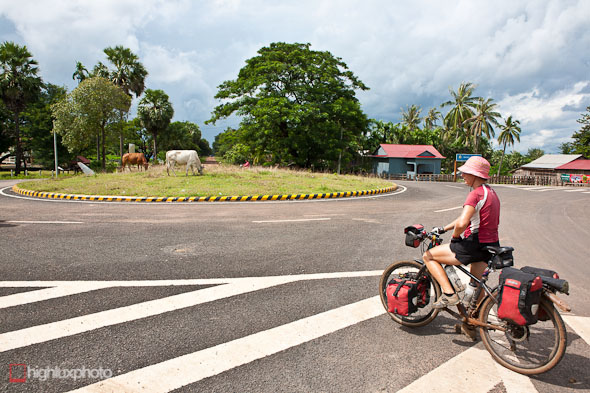
After a morning checking out Koh Ker we pedalled a cruisy 24km to Kuleaen, a 1-guesthouse town, and spent the night there. Since leaving Siem Reap mains power has been rare, with most towns relying on generators.

Next day we rode 79km of wide rolling highway through endless wetlands and arrived in Sra Aem, the stopping off point for the Prasat Preah Vihear temple. The temple itself sits right on the border with Thailand and is the centre of a long running border dispute between the two countries. Tensions came to a head in recent years with shellings on both sides, and military and civilian casualties. There is a ceasefire in place currently, but Sra Aem was still teeming with Cambodian soldiers, brothels and stores selling camo gear.

We wandered through the muddy market looking for our usual staples: bananas and biscuits; and couldn’t help but stop and watch as this woman steadily worked through a pile of chickens, cutting their throats.

I liked this homemade, car-battery powered, coconut meat extracting device.

Prasat Preah Vihear occupies a lonely and commanding postiton atop the Dangkrek Mountains, a sandstone escarpment that divides Cambodia and Thailand. We wanted to be there for sunrise, so organised a 4WD to pick us up at 5am for the 50 minute drive. We didn’t get a sunrise and mist obscured the views for most of the day but the site did not disappoint; with its isolated position, stately ruins and only a small trickle of tourists compared with Angkor.

The temple’s history is riddled with conflict: the Thais raided the place several times, at one point attempting to tear it down with elephants; during the civil war Lon Nol forces here were the last to fall to the communist Khmer Rouge, who in turn held positions there until they were driven out by the Vietnamese. The Vietnamese have left their mark with crude concrete bunkers scattered about. Despite the site crawling with bored soldiers it’s quiet, but the bulletholes in the walls, shell craters and minefields tell another story.
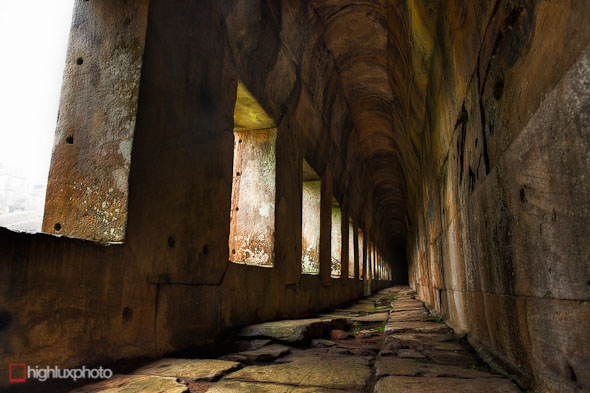
The temple is largely unrestored, and simply propped up with wooden frames in places. Some intact passages give a sense of the temple’s original grandeur though.

The commanding officer of the Cambodian soldiers even dropped by to say hello while we wandered around in the mist.

We’d organised for our driver to pick us back up at 6pm, giving us 12 hours to hang out at the temple and mountain top. We spent a lot of the day hanging out on a sandstone ledge reading our books and waiting for the cloud to allow us a view of the plain below.
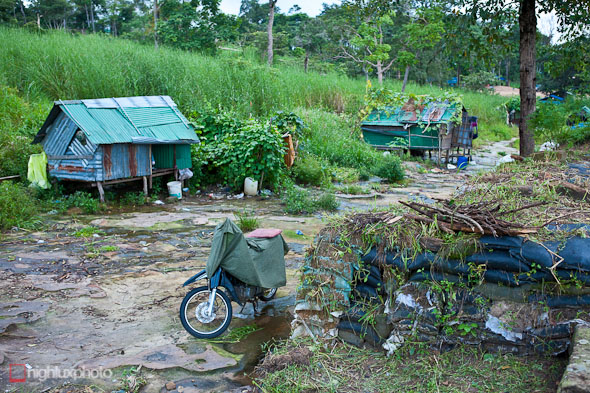
We were amazed by the squalid conditions the hundreds of soldiers there were living in; tiny, mouldy huts in the creekbed and crude sandbagged emplacements that were slowly being recliamed by the jungle. Many soldiers seemed to have their wives in tow, and the area had the feel of many of the small villages we’ve passed through in this part of the world.

There seemed to be a pretty lax attitude to security though…

A sign we were pleased to see.
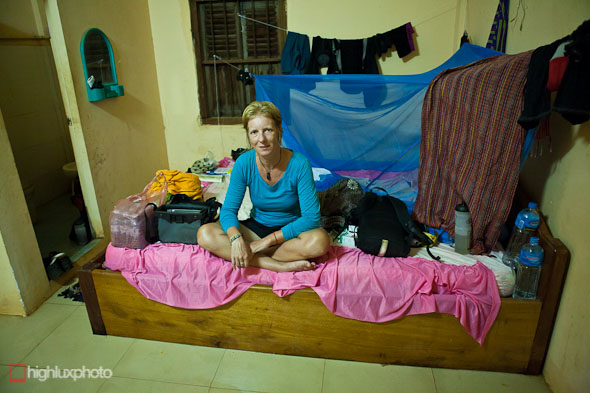
Sra Aem felt like the wettest place on earth (after the Tutoko Valley) while we were there. The morning we left for the temple we’d woken to a flooded guesthouse room, with three inches of water on the floor and our stuff floating around (thank God for Ortlieb panniers!), to top it off some eels had swum in and were cruising around the room. We piled everything onto the bed and into the bathroom, which was slighly higher, and left hoping for the best. When we returned 14 hours later the water had peaked even higher – flooding the bathroom too – and then subsided completely, leaving hideous piles of squirming worms and mud under our bags. We still had one more night to spend there too, sleeping in a damp and mouldy bed.
Click on the thumbnails below for more photos from these temples…






Cool! I’ve been waiting to see these shots, and well worth the wait. Hope you’re enjoying Malaysia x